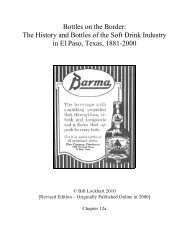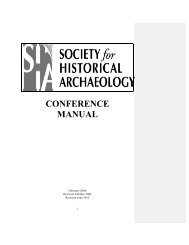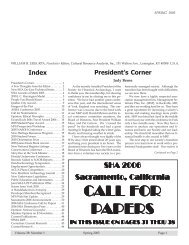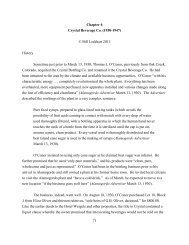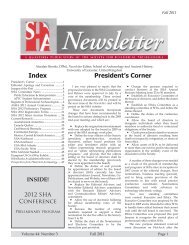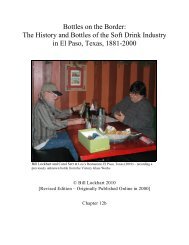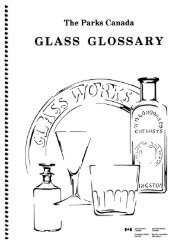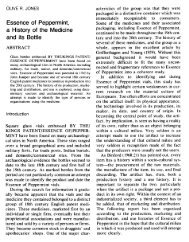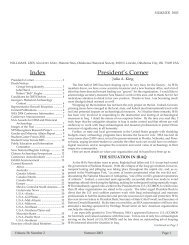Bottles on the Border: The History and Bottles of the Soft Drink ...
Bottles on the Border: The History and Bottles of the Soft Drink ...
Bottles on the Border: The History and Bottles of the Soft Drink ...
Create successful ePaper yourself
Turn your PDF publications into a flip-book with our unique Google optimized e-Paper software.
spokes, <strong>and</strong> <strong>the</strong> girls rinsed bottles <strong>on</strong> <strong>the</strong>m (40-50,000 per day) prior to filling which was<br />
accomplished in <strong>the</strong> next secti<strong>on</strong> (Apollinaris Brunnen 1976:6-8).<br />
<strong>The</strong> water was pumped by steam power to <strong>the</strong> gallery where fifty men <strong>and</strong> boys filled <strong>and</strong><br />
corked each bottle, “<strong>on</strong>e man filling <strong>and</strong> corking while ano<strong>the</strong>r wired” <strong>on</strong> twenty-<strong>on</strong>e bottling<br />
machines. <strong>The</strong> remaining men carried bottles. On average <strong>the</strong> men filled 40,000 bottles each<br />
day (Apollinaris Brunnen 1976:8-9).<br />
<strong>The</strong> effervescence caused by <strong>the</strong> “carb<strong>on</strong>ic acid gas” was str<strong>on</strong>g <strong>and</strong> was produced<br />
without “admixture or foreign agent.” <strong>The</strong> gas escaping from <strong>the</strong> spring itself was so str<strong>on</strong>g that<br />
<strong>the</strong> gates were kept locked to avoid accidental inhalati<strong>on</strong>. <strong>The</strong> English journalist described <strong>the</strong><br />
water as “clear as crystal, s<strong>of</strong>t as velvet, <strong>and</strong> effervescent as champagne . . . not <strong>on</strong>ly <strong>of</strong> <strong>the</strong><br />
highest purity, but preserves its sparkling freshness l<strong>on</strong>ger than any artificially aerated water”<br />
(Apollinaris Brunnen 1976;9-12).<br />
<strong>The</strong> bottles were packed in “huge obl<strong>on</strong>g boxes <strong>on</strong> wheels, in each <strong>of</strong> which 4000 pints or<br />
3000 quart bottles were already packed away” <strong>on</strong> “a dozen wagg<strong>on</strong>s (sic).” <strong>The</strong>se were taken to<br />
Remagen <strong>on</strong> <strong>the</strong> Rhine River where <strong>the</strong>y went to Engl<strong>and</strong> or o<strong>the</strong>r destinati<strong>on</strong>s outside Germany.<br />
In 1875, <strong>on</strong>e milli<strong>on</strong> bottles were shipped within Germany with an equal number to Holl<strong>and</strong>.<br />
Engl<strong>and</strong>, <strong>the</strong> company’s largest customer, received six milli<strong>on</strong> bottles. <strong>The</strong> journalist quipped<br />
that “<strong>on</strong> <strong>the</strong> whole, <strong>the</strong> Ahr valley pr<strong>of</strong>its largely by <strong>the</strong> badness <strong>of</strong> our drinking water<br />
(Apollinaris Brunnen 1976:13-14).<br />
Kreuzberg died in 1876, <strong>and</strong> his heirs reformed <strong>the</strong> company naming it Aktiengesellschaft<br />
Apollinaris-Brunnen, vorm (An<strong>on</strong>ymous [1993]:110-111). In 1897, Frederick Gord<strong>on</strong> <strong>of</strong><br />
Engl<strong>and</strong> purchased both <strong>the</strong> English <strong>and</strong> German businesses, although <strong>the</strong> firm returned to<br />
German h<strong>and</strong>s in 1956 when <strong>the</strong> Dortmunder Uni<strong>on</strong> Brauerei gained a c<strong>on</strong>trolling share <strong>of</strong> <strong>the</strong><br />
stock. <strong>The</strong> company, by <strong>the</strong>n know as Apollinaris Brunnen, merged with Schweppes GmbH in<br />
1991, <strong>and</strong> Cadbury Schweppes acquired <strong>the</strong> voting share <strong>of</strong> <strong>the</strong> stock in 2002 (Munsey 2002:10,<br />
14).<br />
A poster ca. 1899 advertises “A Whiskey <strong>and</strong> a Small ‘Polly’” (Munsey 2002:11),<br />
suggesting that Apollinaris water was used as a chaser for alcoholic drinks. <strong>The</strong> nickname<br />
“Polly” was apparently in use by that time but faded into obscurity later. A photo <strong>of</strong> an unnamed<br />
bar in El Paso shows posters from Apollinaris featuring “Pretty Polly,” a race horse sp<strong>on</strong>sored by<br />
<strong>the</strong> company, as well as bar ads for Lemp Beer <strong>and</strong> White Rock water (Figure 5-30 & 5-31).<br />
94






